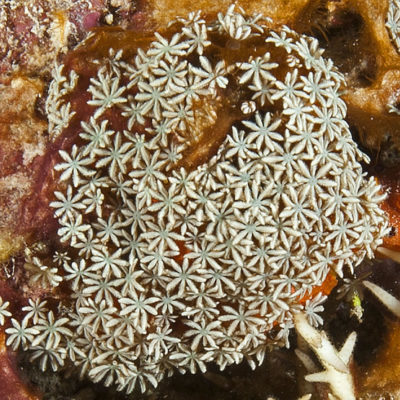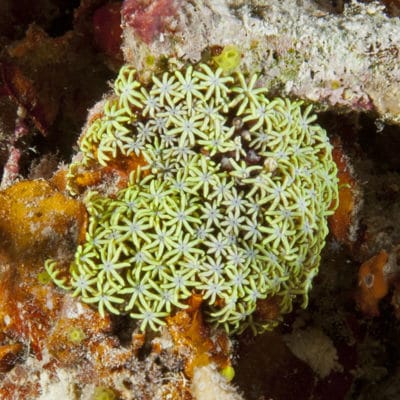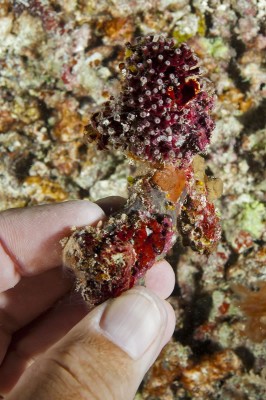Expedition Log: Palau – Day 18
When I was writing the blog for the Blue Coral (Heliopora coerulea) I found and learned about earlier in this mission, I came across a reference for Organ Pipe Coral (Tubipora musica). While Blue Coral is the only known soft coral (subclass Octocorallia) to produce a truly massive skeleton composed of aragonite (calcium carbonate) I did learn of the second species of octocoral to produce an aragonite skeleton and that was Organ Pipe Coral. The skeleton produced by this coral species is less dense and massive than that of Blue Coral being composed of thin tubes (pipes) only a couple of millimeters in diameter which are cross-linked by horizontal plates. This parallel arrangement of tiny tubes is the source of the common name for this coral.

The small and dainty polyps of Tubipora musica exhibiting their eight-way symmetry which makes them members of the subclass Octocorallia.
Unlike the distinctive (and unique) blue coloration of Heliopora the skeleton of Tubipora is bright red in color. This red coloration is the result of organic pigments (including carotenoids) which are incorporated into the aragonite skeleton. Carotenoids are the pigments responsible for the orange to red coloration in many plants and animals. They got their name, unsurprisingly, by giving carrots their distinctive color, though many other fruits and vegetables owe their coloration to carotenoids—peaches, cantaloupe, sweet potatoes, and pumpkins to name a few. Interestingly, carotenoids are only synthesized by plants and cannot be produced by animals. So though Lesser Flamingos acquire their pink coloration from a carotenoid called Astaxanthin they absorb this pigment from their diet of brine shrimp. The shrimp, in turn, receive this pigment from their diet of microalgae which actually produce the pigment. For Tubipora it is likely that they obtain their pigments from feeding on phytoplankton.

While the polyps of most of the small colonies of Tubipora had pale cream colored polyps, this colony had vibrant fluorescent yellow polyps. The camera strobe unfortunately diminishes much of the fluorescence and colony was much more stunning to the naked eye.
This unusual bright red skeleton has made Tubipora sought after as both live specimens for the aquarium trade as well as being harvested for its skeleton to be used as curios and in the manufacture of jewelry. As a result of extensive harvesting as well as the threats of climate change, habitat loss and the degradation of reefs, this species is classified as Near Threatened on the IUCN Red List and is listed under Appendix II of CITES.

Most of the Tubipora colonies that I encountered that day were not much bigger than a ping pong ball but this colony was the size of a head of cabbage making it the biggest specimen I noticed throughout the entire trip.
While this coral may be relatively abundant on some mid-shelf reefs on the Great Barrier Reef and in areas of the Red Sea, it did not ever form a major component of the reefs we surveyed in Palau. I had seen the occasional small patch of Organ Pipe Coral on a few dives but it was not till we were diving on a patch reef in a channel along Cormoran Reef in the lagoon north of the large island of Babelthuap that I noticed it more frequently. We dropped in for a survey dive and found ourselves on a rubble field at 20 meters depth. The substrate was cobbled with fragments of broken-up coral coated with turf algae and cyanobacteria lending them a fuzzy texture. Still, among the rubble there were many small clumps of several species of branching corals—Acropora, Seriatopora, Pocillopora and Paraclavarina—showing that the reef was in the process of rebuilding after being ravaged by super typhoon Haiyan. As we swam along at 20 meters for some distance looking for the reef slope to take us to shallower depths, we passed interesting outcrops dominated by unusual and unfamiliar coral assemblages. In one area small fragments, or possibly recruits, of Galaxea corals dominated the rubble bottom. These gave way onto a field of small unattached Goniopora corals with plumes of either tan or fluorescent yellow polyps extended. Because of the low relief and meager coral cover on this rubble field transitioning once again to reef, I was able to more clearly pick out the delicate polyps on the small fragments of Organ Pipe Coral with their tiny oral discs encircled by eight tentacles feathered with even finer pinnules. When I picked up one of these small pieces of rubble the tiny polyps retracted and I could clearly see the tubular skeleton. Because red wavelengths are quickly absorbed by water, objects with red hues tend to lose their color and appear dark at the depth we were at. A quick application of my underwater dive light restored the red coloration to the skeleton confirming that what I was seeing was indeed Tubipora musica—the Organ Pipe Coral.

The distinctive red skeleton on this small specimen is clearly visible once the polyps have retracted and the light from the strobe on my camera has restored the true color.
A few days later we were able to make a rare land visit during our mission. We had the chance to go to the remote Kayangel Atoll and go ashore on the small islet to visit with the locals, go snorkeling in the seagrass beds, or simply walk the beach and enjoy feeling terra firma under our feet for the first time in nearly a month. As I walked along the beach I noticed the showy dabs of red among the white line of shell hash left at the previous high tide line. Closer inspection confirmed my suspicion that this red was not due to any piece of plastic—which is all too ubiquitous in the oceans these days—but was in fact a small nugget of Organ Pipe Coral skeleton. I soon dubbed these “beach strawberries” and was on the hunt for a nice specimen to photograph, for I knew that I would now certainly have to write a blog about the other species of octocoral to leave a lasting (and colorful) aragonite remnant.

The bright red coloration of a couple of “beach strawberries” that I spotted while walking the beach. The tubular form of the Tubipora skeleton with the horizontal connecting plates can be more easily seen here.
Photos by Ken Marks.